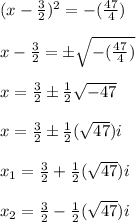Answer:

Explanation:
In this problem we have the equation of the following quadratic equation and we want to solve it using the method of square completion:

The steps are shown below:
For any equation of the form:

1. If the coefficient a is different from 1, then take a as a common factor.
In this case
 .
.
Then we go directly to step 2
2. Take the coefficient b that accompanies the variable x. In this case the coefficient is -3. Then, divide by 2 and the result squared it.
We have:

3. Add the term obtained in the previous step on both sides of equality:

4. Factor the resulting expression, and you will get:

Now solve the equation:
Note that the term
 is always > 0 therefore it can not be equal to
is always > 0 therefore it can not be equal to

The equation has no solution in real numbers.
In the same way we can find the complex roots:
